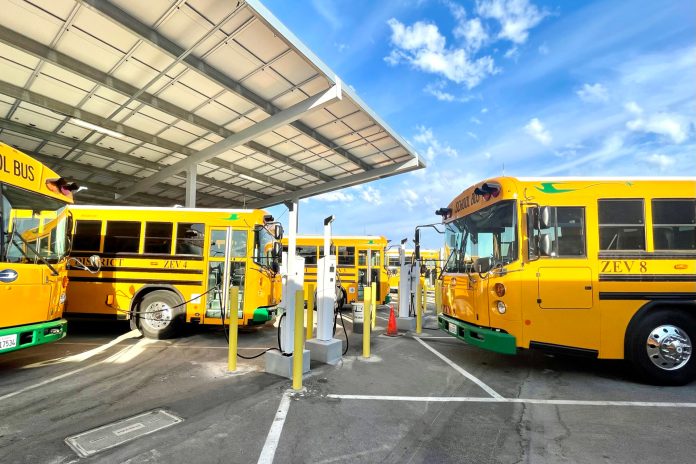The recent enactment of the bipartisan Infrastructure Investment and Jobs Act is an important step on the path to cleaner school bus rides for the more than 20 million children who rely on an iconic yellow bus every day — and a chance for states to follow with bold action.
The new law makes an unprecedented investment in electric school buses (ESBs), appropriating $2.5 billion to help school districts adopt zero-emission school buses, such as ESBs, and another $2.5 billion toward zero- and low-emission school buses, such as CNG and propane.
Although the Clean School Bus Program is the largest amount of funding ever established to electrify school buses, this investment is still not enough to transition the entire fleet of 480,000 school buses to electric vehicles. States will play a critical role in bridging the current upfront cost gap.
How States Can Bring the Benefits of Electric School Buses to Their Communities
Here are five specific ways that state leaders can position their school districts for a successful, equitable transition to electric school buses:
1. Set Ambitious Goals and Build a Supportive Policy Environment
Policymakers should consider how electric school buses fit within a state’s broader transportation electrification goals. On the regulatory and legislative fronts, states can set targets that help propel the market forward.
State policymakers should move immediately to adopt California’s Advanced Clean Trucks rule (ACT), which includes school buses. The ACT sets increasing zero-emission vehicle sales requirements for medium- and heavy-duty vehicle (MHDV) manufacturers. Massachusetts, New Jersey, New York, Oregon and Washington adopted the rule in 2021, and more states are considering adoption this year.
State adoption of the ACT will bring cleaner air to impacted communities while bringing zero-emission trucks and buses to scale. Adopting the ACT is an important first step to codifying the goals of a memorandum of understanding now signed by 17 states and the District of Columbia.
This agreement established a shared goal of cleaning up MHDV fleets, including school buses, by reaching 30 percent zero-emission MHDV sales by 2030 and 100 percent zero-emission MHDV sales by 2050. In addition to these efforts on new sale requirements, state leaders should review procurement laws and other state regulations and modify them as needed to bolster ESB deployment.
Within these broader transportation electrification efforts, school buses offer a promising ground and a place to move more quickly, as over 90 percent of school bus routes can be served with today’s electrification technology. ESB deployment can be a catalyst for broader MHDV electrification and a down payment toward cleaning up the entire sector.
Related: 6 Myths About Electric School Buses – Debunked
Recognizing this potential, New York state recently codified a commitment to the first state-wide transition to a zero-emission school bus fleet in the country.
2. Provide Dedicated Upfront Funding
States have already awarded over $480 million in electric school buses and infrastructure funding, including approximately $180 million in 28 states through Volkswagen (VW) settlement funds. However, VW settlement funds are a one-time funding source that many states have already exhausted or will soon deplete. Additional new sources of funding are needed to support school districts and school transportation providers to cover the cost of new ESBs while the market continues to mature and until total cost of ownership parity is achieved.
Supportive financing options, including through state green banks, are also critical parts of the funding and financing landscape that can help school districts leverage the lower operational and maintenance costs of ESBs. States should dedicate a significant amount of funding to electric school buses, with at least 40 percent of this funding supporting ESB deployment in traditionally underserved communities.
California currently offers the most robust state funding for ESBs through its Hybrid and Zero-Emission Truck and Bus Voucher Incentive Program. The state is allocating $130 million exclusively for electric school buses this year.
States should put in place generous incentives now to increase uptake and phase them out over the next few years as the market matures, production increases and prices decline. For example, in Colorado Gov. Jared Polis has proposed a new 10-year $65 million program for school bus electrification as part of an air quality investment package.
Related: Colorado Legislature Greenlights $65M for Purchasing Electric School Buses
Related: Proposed California Education Budget Includes 3-Year, $1.5B Electric School Bus Program
3. Incorporate Technical Assistance and Workforce Development Strategies
States should also provide technical assistance to school districts as they manage the transition of their fleets. School districts are navigating an unprecedented pandemic and managing the educational needs of their students during a challenging time — they will need guidance with this new transportation option and its complexities. States are well-positioned to step in and offer that guidance to school district staff.
Supporting school district staff and drivers must also be part of this technical assistance. The California Energy Commission’s Clean Transportation Program invests directly in workforce development and training entities to expand their current services and develop new programming specifically tailored to zero-emission vehicles.
States need to consider how best to prepare their workforce to thrive as the electric school bus industry continues to evolve, including supporting programs at community colleges and investing in historically underserved communities.
4. Ensure Electric Utility Programs Adequately and Equitably Invest in Charging Infrastructure
State public utility commissions that regulate investor-owned electric distribution utilities have a key role to play in supporting ESB adoption and ensuring a fair and cost-effective transition. This includes oversight of utility rates, transportation electrification planning, and authorization of make-ready infrastructure programs for ESBs.
State regulators should use these authorities to support school bus electrification. Transitioning to electric school buses has the potential to provide benefits to the grid, in addition to reducing harmful emissions from diesel buses.
Related: West Virginia to Pilot Electric School Buses as GreenPower Moves In
Related: EPA Begins Accepting Applications for Year-One Clean School Bus Program Rebates
Related: Three Design Considerations for Electric School Bus Vehicle-to-Grid Programs
Some utility programs may view ESBs as grid assets offering the potential for load management to avoid high-cost system peaks and to better allow for the integration of renewable energy generation. When establishing utility electric school bus programs, regulators should consider best practices for rate design that limit increased costs and maximize equitable outcomes.
5. Incorporate Equity into All Aspects of ESB Program Design and Implementation
It is essential that all the above approaches place equity and environmental justice at the forefront. ESBs represent an opportunity to address the disproportionate burden of pollution experienced by people in traditionally underserved communities across the U.S.
One state that is leading the way on this front is New Jersey. The state Senate is considering legislation that would bolster and expand electric school bus grants administered by the Department of Environmental Protection. At least half of the grants would be awarded to school districts serving low-income or environmental justice communities.
Examples of Recent State Legislative Activity on Electric School Buses
Governors and state legislatures across the country are prioritizing electric school buses and in 2021, bills involving electric school buses were introduced in at least 11 states. Four of these bills were passed and signed into law. In the table below we share examples that illustrate a range of state legislative approaches.
TABLE 1: Illustrative Examples of 2021 State Legislation on Electric School Buses
| Policy approach | Description | Example 2021 Legislation |
| State-administered ESB program | Establishes state grant or voucher programs administered by a state agency. May be a separate electric school bus program or integrated into existing program. | S4077 New Jersey;
HB 2118 Virginia |
| Utility ESB investment program | Establishes programs within state public utility commissions authorizing investor-owned utility programs. Key decision points include determining which expenses are eligible to be rate-based. If Vehicle Grid Integration is a component of the program, these proposals may specify whether the utility or school district owns the bus and/or battery. | HB 832 Maryland; SB 1380 Virginia |
| Broader utility electrification transportation planning | Incorporates ESBs into broader utility electrification planning proposals, which may in turn be included as part of larger climate, clean energy, and transportation bills. These bills typically require utilities to submit transportation electrification investment plans and may also require public utility commissions to study or recommend best practices. | SB 21-260 Colorado;
SB 448 Nevada; Public Act 102-0662 Illinois |
| Sales tax, loan terms, and tax exemptions | Lowers the financial cost of ESBs by exempting school districts from certain costs associated with ESBs, including sales tax on a purchased bus or use tax on transportation fuel. These modifications may be made through amendments to existing education statutes or state education aid reimbursements. | S5268 New York;
HB 2184 Oregon |
| Public fleet electrification | Requires public fleets within a state to electrify. May be targeted only at school districts or include all public fleets including transit and state government fleets. | LD 1579 Maine; S.2255 Massachusetts |
| Green schools | May address multiple elements of reducing energy usage at public schools, including installing renewable energy, building energy efficiency upgrades, and school bus electrification. | H942 North Carolina;
HB 4120 Texas |
Note: Bolded text indicates bills that have been passed and enacted into law.
With a wide range of electric school bus policies and program options available, and a unique opportunity to leverage a historic federal investment, states have an unprecedented window in 2022 to accelerate an equitable transition to electric school buses. Now is the time for states to create new jobs, combat climate change and deliver cleaner commutes for kids.
School Transportation news edited this article originally published by WRI’s Electric School Bus Initiative for style and space. It was republished with permission.
Editor’s note: WRI’s Sue Gander, director of the school bus electrification project, speaks on a July 19 panel at STN EXPO Reno on the Clean School Bus Program.

Katrina McLaughlin is a research analyst on the U.S. Energy team, working on clean energy, electricity market design, and transportation electrification.

Justin Balik is senior manager of state policy for transportation electrification. He currently leads state level engagement and strategy for WRI’s Electric School Bus Initiative.
















